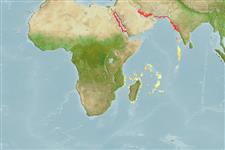Common names from other countries
>
Gobiiformes (Gobies) >
Gobiidae (Gobies) > Gobiinae
Etymology: Gobiodon: Latin, gobius = gudgeon + Greek, odous = teeth (Ref. 45335); irregularis: Named for its variable colouration, mainly its irregular red wavy lines on the head and upper body in juveniles and subadults..
Environment: milieu / climate zone / depth range / distribution range
Ecologia
marinhas associadas(os) a recifes. Tropical
Western Indian Ocean: Gulf of Aqaba, Red Sea and Rodrigues.
Tamanho / Peso / Idade
Maturity: Lm ? range ? - ? cm
Max length : 3.2 cm SL macho/indeterminado; (Ref. 94082)
Descrição breve
Morfologia | Morfometria
Espinhos dorsais (total): 7; Raios dorsais moles (total): 10-11; Espinhos anais 1; Raios anais moles: 9 - 10. This species is distinguished by the following characters: D VI+I,10-11 (usually 11); A I,9-10 (usually 9); head and body are naked; body is relatively elongate (depth 35.1-39% SL) and compressed; head is slightly pointed in juveniles, becoming more rounded in adults; snout sometimes has a slight hump above upper lip; groove between isthmus and interopercle absent; slender caudal peduncle (depth 14.5-15.8% SL); caudal fin is relatively long (22.6-24.6% SL); colour of juveniles and subadults greenish or brownish green with up to 7 red bars with bluish interspaces on head and pectoral-fin base, 3 anteriormost bars also run across eye; nape and dorsal part of body with irregular red lines and small spots; lines and dots usually vanish in adults of more than 3 cm TL; body becomes uniformly brown or reddish brown, usually with remnants of the orbital and suborbital bars (Ref. 94082).
Facultative air-breathing in the genus (Ref. 126274); This species exhibits a generalised habitat selection and occupies a great range of Acropora
corals. It is found in deeper water regions, at lower reef slope and fore reef areas, and is most common in corals such as Acropora samoensis, A. valida and A. secale, but was also observed in Acropora eurystoma and A. pharaonis in the northern Red Sea (Ref. 94082).
Life cycle and mating behavior
Maturidade | Reprodução | Desova | Ovos | Fecundidade | Larvas
Herler, J., S.V. Bogorodsky and T. Suzuki, 2013. Four new species of coral gobies (Teleostei: Gobiidae: Gobiodon), with comments on their relationships within the genus. Zootaxa 3709(4):301-329. (Ref. 94082)
Categoria na Lista Vermelha da IUCN (Ref. 130435)
CITES (Ref. 128078)
Not Evaluated
Ameaça para o homem
Harmless
Utilização humana
Mais informação
Nomes comunsSinónimosMetabolismoPredadoresEcotoxicologiaReproduçãoMaturidadeDesovaFecundidadeOvosDesenvolvimento dos ovos
Idade/TamanhoCrescimentoComprimento-pesoComprimento-comprimentoFrequência de comprimentoMorfometriaMorfologiaLarvasDinâmica larvarRecrutamentoAbundância
ReferênciasAquaculturaPerfil para aquaculturaEstirpesGenéticaElectrophoresesHereditariedadeDoençasProcessamentoMass conversion
ColaboradoresFotografiasStamps, Coins Misc.SonsCiguateraVelocidadeTipo de nataçãoÁrea branquialOutras referênciasCérebrosVisão
Ferramentas
Relatórios especiais
Descarregue XML
Fontes da internet
Estimates based on models
Preferred temperature (Ref.
115969): 24.7 - 29.3, mean 27 (based on 140 cells).
Phylogenetic diversity index (Ref.
82804): PD
50 = 0.5000 [Uniqueness, from 0.5 = low to 2.0 = high].
Bayesian length-weight: a=0.01995 (0.00906 - 0.04395), b=3.01 (2.83 - 3.19), in cm Total Length, based on all LWR estimates for this body shape (Ref.
93245).
Nível Trófico (Ref.
69278): 3.3 ±0.4 se; based on size and trophs of closest relatives
Resiliência (Ref.
120179): Elevada, tempo mínimo de duplicação da população menor que 15 meses (Preliminary K or Fecundity.).
Fishing Vulnerability (Ref.
59153): Low vulnerability (10 of 100).
